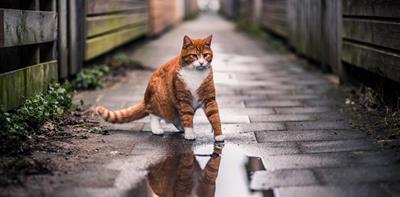
Moving home can be both exciting and stressful. For pets, who are used to their safe home environment, moving can cause real anxiety.
Ahead of the move, you’ll no doubt be busy with packing and paperwork. But if you do have pets it’s important to set aside some time to plan how you can make the move as stress-free as possible for them.
Here are some steps you can take before and during the move, and then once you’re in your new home.
Before the move
- Before, during and after the move, try and keep your pet’s environment and routine as consistent as possible. That might include feeding, walks, playtime and bedtime.
- Consider your pet when packing. You want to keep their home environment as familiar as possible. So, if you can, keep all of your boxes and other packing out of sight of your pet until closer to your moving day. If you can, hold off packing your pet’s sleeping area, toys and other familiar items until the last minute.
- If you’re moving to a new area, you’ll need to register your animal with a new vet. It’s much better to have it sorted now, in advance, rather than waiting until your pet gets sick or injured. The same goes for updating microchips and collars. Add these tasks to your moving list, alongside the obvious admin of registering with a new doctor or informing utility companies.
During the move
- The move itself can be hectic. It can save you and your pet extra grief to keep them out of the way entirely - either in a kennel or cattery or staying with friends or family. Ideally you can then collect your pet once you’ve unpacked and made your new home less chaotic and more welcoming.
- If you do opt for a cattery or kennel, remember to dig out any documents you need to take with you, such as an up-to-date vaccination certificate and proof of flea and worm treatments. It’s easy to forget or misplace these at the best of times, let alone when shifting all of your possessions to a new home.
- Unless you’re moving just a couple of streets away, you’ll probably need to take your pet in the car with you. You’ll need to restrain them properly. If you have a dog you'll need to safely secure them in the car. If you have a cat, use a suitable cat carrier with familiar smelling bedding. Putting this carrier out well in advance of the move should help to reduce their anxiety when it comes to putting them inside it.
- You may have noticed how well your pet can read your body language and emotions. VCA Animal Hospitals says that if you’re anxious that may add to your pet’s anxiety. On the other hand, if you are happy and upbeat it might help reduce your pet’s anxiety during the move. So, try your best to stay positive.
- Try giving one family member sole responsibility for your pet on moving day, so you always know it’s taken care of and won’t get lost or run away in the chaos of moving.
- Prepare your new home before you bring your pet along. Among steps recommended by the American Society for the Prevention of Cruelty to Animals are to tuck away electrical cords, plug up nooks where your pet could get stuck, and remove any poisonous houseplants.
- A new home can smell unusual, even to a human. For a cat or dog, those alien smells can cause a lot of anxiety, especially if the previous owners also had pets - in which case you’ll have to clean the house thoroughly to remove their scents. Animal charity Blue Cross recommends rubbing a soft cotton cloth gently around your cat’s face to pick up their scent and then dabbing it around on the furniture so that the cat begins to feel at home and bonds with the territory. Alternatively, you can buy plug-in pheromone diffusers or sprays.
In your new home
- On arrival at your new home, confine your pet to one room. This can be a safe zone where you should try and re-create their old bedding set-up, alongside any toys, litter tray for cats and food and water. Keep the door and windows closed and if there are still lots of people moving about and unpacking, you could put a sign on the door to warn them to stay out of this one particular room.
- At the end of the day, let your pet out of their safe room and into the rest of the house. Accompany them and reassure them as they explore their new home environment.
- If you have a dog, don’t forget that on moving day, they’ll still need their usual exercise. Keep them on a lead and take advantage of a break from packing and an opportunity to gradually get to know your new neighbourhood. Before letting them run free in the garden for the first time, check the boundaries to be sure they can’t escape into an unfamiliar environment and get lost.
- A cat on the other hand will need to be kept indoors for at least two weeks. After that, accompany them for their first forays into the garden to make them feel safe. Try doing this just before a meal, so you can entice them back in with their food.
- If you aren’t moving very far, your pet might try and return to your old home. So it might not hurt to ask your old neighbours to keep an eye out for them. Also, you might give a picture of your pet to the people who bought your home from you, along with your contact details, in case your pet finds its way back to its old stomping ground.
Be patient and spend time with your pet
Depending on your pet’s personality, it might take some time for them to settle in. The really important thing is to spend lots of time with them while they explore their new environment, reassure them and be patient if they misbehave or have accidents. Then you can create a new home that both your family and pets can enjoy.

